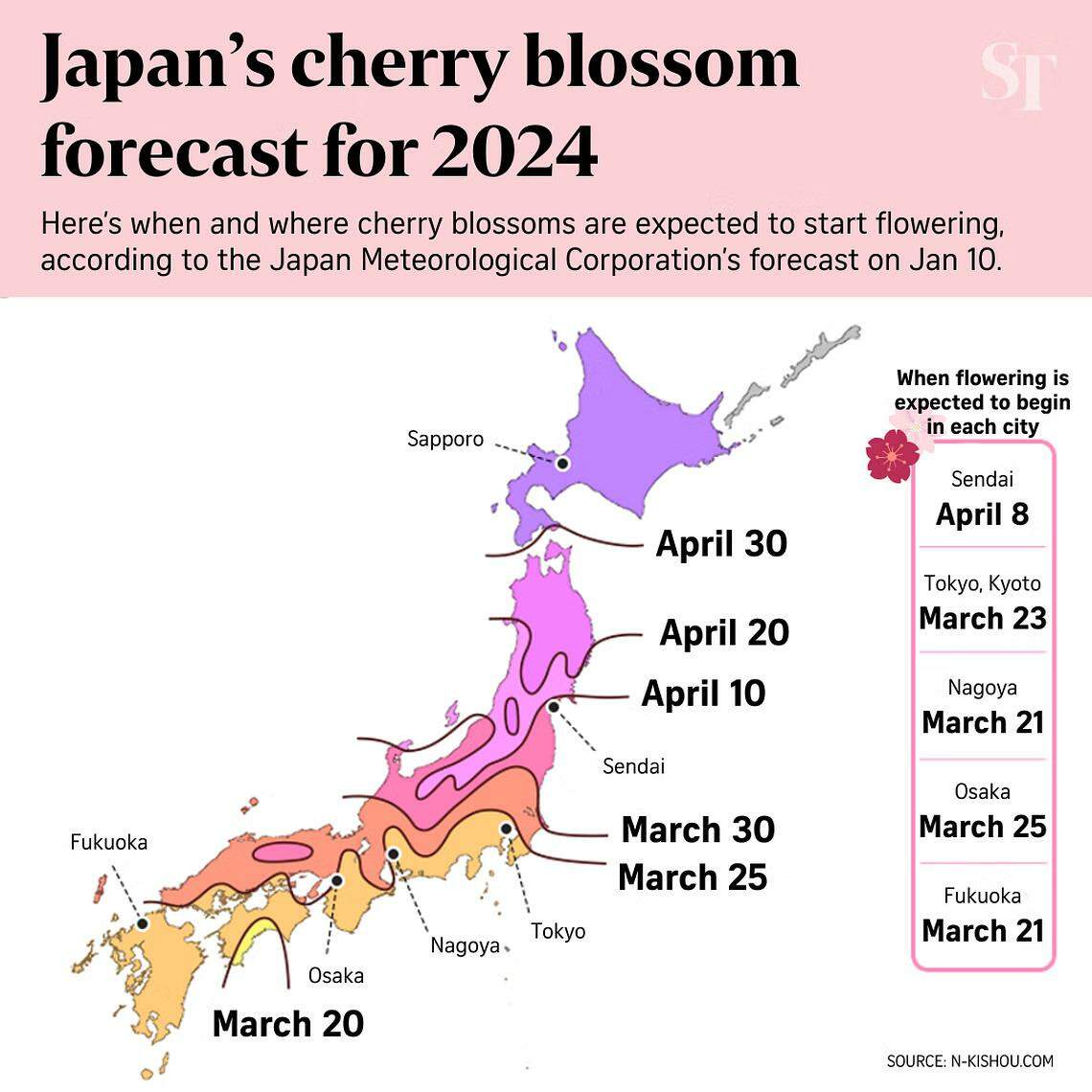TOKYO – Tokyo is poised to buck historical trends and become the first area on mainland Japan where the famous sakura (cherry blossoms) flower and enter full bloom.
In fact, the ephemeral flower, which lasts about two weeks and heralds the dawn of spring, is blooming earlier than before across the country due to global warming.
The Japan Weather Association (JWA) predicts that for 2024, the sakura will flower in Tokyo on March 19 and reach full bloom on March 25 – both dates the earliest across Japan.
Another prediction, by the Japan Meteorological Corporation (JMC), has the sakura flowering in Tokyo on March 23. Full bloom is forecast on March 30, earlier than in areas such as Kyoto and Osaka.
Tokyo is suffering the double whammy of warmer temperatures and the “heat island effect”, Japan Meteorological Agency (JMA) climate risk management officer Daisuke Sasano said on March 12. The heat island effect refers to how urban areas are warmer than rural regions as heat is absorbed and reflected by man-made structures.
JMA records show that mean temperatures across Japan have risen 1.6 deg C in the last century, with 2023 the hottest year on record. In Tokyo, however, the mercury has spiked an average 3.3 deg C over 100 years.
All 47 prefectures have at least one “specimen tree”. When five to six flowers on the specimen tree open, the sakura in an entire region is said to have started flowering. Full bloom happens when 80 per cent of the buds of the tree have opened.
Tokyo was the mainland’s earliest bloomer just twice before, in 2020 and again in 2023, when the specimen somei-yoshino tree in the city centre began flowering on March 14 that year.
On Kyushu island, the sakura flowered on March 21 in cosmopolitan Fukuoka and April 1 in rural Kagoshima in 2020, and March 18 and March 24 respectively in 2023.
This is a departure from what the JMA describes as the traditional “cherry blossom front”, which has historically moved upwards from the south-western island, with shorter winters, towards Hokkaido in the north-east. This refers to the direction in which Japan becomes awash in pink as the sakura flower and bloom.
The JMA, as the government’s weather agency, analyses past data but does not issue forecasts, which are now the domain of private weather companies like the JWA and JMC.
Mr Sasano, 46, said that with the changing trends, the meaning of the sakura is changing across generations.
For him, the sakura in full bloom in April “signified new beginnings” as he was growing up, coinciding with the dawn of a new fiscal year in Japan when school orientation and company entrance ceremonies are held.
His daughter, however, sees it as a “symbol of graduation and farewells”. At 15, she is of the age when children graduate from junior high school in March and begin senior high school in April.
“(Across the country) since 1953, the average start date for the sakura to bloom has become earlier, at a pace of 1.2 days every 10 years,” said Mr Sasano.

There are nine species and over 300 varieties of sakura in Japan, according to the Japan Cherry Blossom Association. The somei-yoshino, being the most common, is used as the standard except in areas where it cannot be grown.
The sakura is not to be confused with the plum blossom (ume) and the peach blossom (momo), which are other similarly pink flowers that bloom around the same time but are not considered native to Japan.
There are also localised sakura varieties, including those native to the Shizuoka prefecture cities of Atami and Kawazu, which bloom even earlier than the somei-yoshino.
A Japan Environment Ministry study has found that the time between the sakura’s flowering and full bloom will shrivel by the end of this century in line with higher temperatures, which will lead to fewer days to enjoy the pink flowers.
JMC weather forecaster Hiroki Ito told The Straits Times that cherry blossom buds are formed the previous summer, but lie dormant until their awakening during a frigid winter. They then resume their growth towards flowering in the warmth of spring.
This means warmer, shorter winters and earlier springs will affect when the sakura are in bloom and for how long.

In southern regions like Kyushu, which is warmer, hotter winters will delay when the sakura buds awaken, Mr Ito said. This could lead to a significant delay in their flowering, and there may even be areas where they fail to bloom.
But in north-eastern Japan, which is accustomed to frigid winters, the sakura may bloom significantly earlier with the earlier onset of warmer temperatures, as the timeframe between the buds’ awakening and blooming is shorter.
There has already been a noticeable impact.
In 2023, bus tours to a famous sakura-viewing spot in Fukushima, renowned for a weeping 1,000-year-old tree that is deemed a national treasure, were partially scrapped as full bloom came on a historically early April 1. This was two weeks sooner than average.
The Hirosaki Cherry Blossom Festival in Aomori, which dates back to 1918 and has historically been held from April 23 to May 5, will begin four days earlier in 2024. Organisers said they are prepared to start even sooner, if the sakura bloom earlier.




